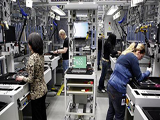A Renaissance in Manufacturing Could Be Our Engine For Growth
Post Views 0
Peter Morici, professor of business, University of Maryland School writes, “U.S. technology should be bolstering manufacturing — that’s how Germany remains a leader in factory jobs. Unless the Germans are smarter than Americans, we should be able to do it too.”
Expressing his viewpoint, in an article, Professor Morici points out that, over the last 12 years, the economy has grown only by 1.6 percent each year. It had the potential of growing by 3 percent. Moreover it hasn’t created a single private sector job. Unemployment would be at 13 percent, if Labor Reports took into account the number of Americans who have stopped looking for work.
Economists feel that our huge trade deficit of around $600 billion needs to be eliminated. Eradicating the trade deficit, the GDP would increase by $1 trillion, and 10 million new jobs would be created. Add to this the weak demand for US made products. We spend our dollars importing things, but cannot get our money back as exports are not in consonance with our imports.
Dependence on foreign oil, we import around 8 million barrels of oil a day, accounts for 44 percent of our trade deficit. Somehow U.S. has to become fuel-efficient. Increased domestic production from the Gulf, Alaska and other offshore deposits could drastically lessen imports.
Manufacturing has been the single most crucial contributor to the recent economic recovery. It has recouped 470,000 of the 5.3 million jobs lost since 2000. Professor Morici writes, “If the United States redressed three quarters of its $650 billion deficit in manufacturers, someone would have to make that stuff, even if at higher levels of efficiency than in the past. The U.S. economy would be 5% larger and policymakers would be worrying about a genuine shortage of workers.”
Over the last few decades U.S. manufacturers have lost market shares to competitors mainly in China. But America still enjoys trade surplus in many industries like aerospace, construction machinery, semiconductors, mining equipment, industrial machinery, basic chemicals, paper, and engines, turbines and power transmission equipment. Moreover, exports of trade in goods manufactured in the US are growing around 10 percent each year.
Increasing wages and rising inflation is making it less and less lucrative for US manufacturers to send goods outside the country for manufacturing. Manufacturing capacity is returning to America. A recent BCG study found, “Within the next five years, the U.S. is expected to experience a manufacturing renaissance as the wage gap with China shrinks and certain U.S. states become some of the cheapest locations for manufacturing in the developed world.”
Manufacturing also contributes to the growth in so many other ways. It pays higher wages and supports two-thirds of all research and development. This research and development generates intellectual property that bolsters and improves our standards of living. America should look to the policies of China, Germany and Japan of how best they can give a boost to the manufacturing sectors.
A Renaissance in Manufacturing Could Be Our Engine For Growth by Harrison Barnes



 Top Five Reasons Talented Employees Quit
Top Five Reasons Talented Employees Quit  San Diego County Back to Full Employment
San Diego County Back to Full Employment  Job Growth Expected in West Michigan Through 2015
Job Growth Expected in West Michigan Through 2015  10 Jobs with the Fastest Growing Salary in 2017
10 Jobs with the Fastest Growing Salary in 2017  Top 10 Universities to Produce Hedge Fund Workers
Top 10 Universities to Produce Hedge Fund Workers  Best and Worst States for Teachers to Teach
Best and Worst States for Teachers to Teach